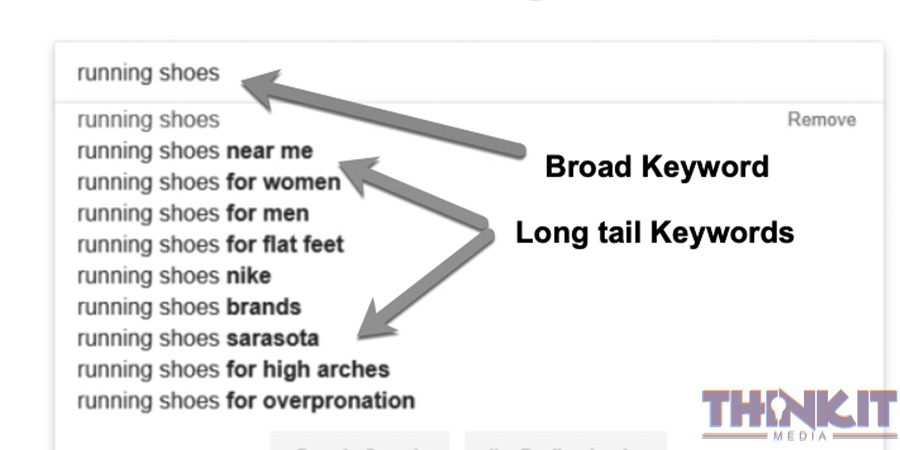If you operate a website or plan on creating one, you’re likely familiar with the term “keywords.” At its simplest, they are the words and phrases people enter into a search engine like Google in hopes of finding the information or product they seek. However, not all search terms are created equal. A vast majority of them are unlikely to generate much traffic and may even be competitive. This is where long-tail keywords come in.
Long-tail keywords are more precise search phrases with generally fewer monthly searches and less competition. They are less “popular” than broad keywords that multiple people are targeting, but much more likely to convert visitors to customers. In fact, the majority of search engine traffic often comes from these precise phrases. Smart marketers know that focusing on long-tail keywords can result in a higher ROI than concentrating on broad phrases that may offer more traffic but less profitability.
Consider this example: A fashion website could target the broad keyword “clothing,” but the competition for that word is fierce, and it would require significant time, effort, and money to rank high on search engine result pages (SERPS). The phrase, “women’s tailored black blazer” is much more specific, fewer people will search for it, but those who do are more engaged and more likely to purchase a blazer.
One of the biggest benefits of targeting long-tail keywords is that it allows you to better understand user intent. With broad keywords, it’s challenging to figure out what someone is searching for precisely. However, the specificity of long-tail keywords makes it much easier to gauge purchasing intent, which ultimately leads to more sales.
How to find Long-Tail Keywords
Long-tail keyword phrases are hidden gems that many website owners fail to notice. However, anyone with a good understanding of their industry and target audience can find them. Here are some of the best research methods for uncovering long-tail keywords:
Brainstorming
Brainstorming is the first stage in the research process where you put yourself in the shoes of your potential customers and think about what they might search for. Start with basic keywords that come to mind, which are closely related to your products or services.
Ask, “If I were my customer, what searches would I perform?” This can be subjective, so team brainstorming sessions can lead to more diverse ideas and help collect more long-tail keywords.
Competitive Analysis
Competitive analysis is another research method for identifying long-tail keywords. Analyze the content of your competitors, their keywords, titles, and ideas. Use tools such as SEMrush, Ahrefs, or Google’s Keyword Planner. Identify the long-tail phrases that they are using.
You can also analyze the comments section of your competitors’ blog posts, social media posts, and discussions board to learn more about the questions potential customers might ask. This information will help you understand what to include in your content and the type of phrases that your target audience uses more often to find information related to products or services similar to yours.
Google Suggest
Google Suggest is a valuable tool that can help you learn what your potential customers are searching for on Google quickly. When you start typing a search into Google, you’ll see several suggestions appear beneath the search bar. These suggestions are popular searches that people often make.
For example, if you type “women’s fashion” into the search bar, Google may suggest “women’s fashion online store,” “women’s fashion clothing,” or “women’s fashion shoes.” These are long-tail keywords that have already been tested by other searchers. By incorporating some of these suggested phrases, you can attract more traffic and potentially more sales.
How to Use Long-Tail Keywords
Once you’ve identified your long-tail keywords, it’s time to start incorporating them into your website content. Here are some tips to use those long-tail keywords effectively:
Start Writing Quality Content
The first step is to produce informative and engaging content that incorporates your long-tail keywords naturally. Avoid stuffing keywords into sentences since it creates a bad reading experience for users and can also hurt your search engine optimization (SEO) strategy.
Your content should be structured and informative. It should also be interesting enough to engage users and make them want to read more. Aim for a balance of quality and keyword integration that improves the experience for both users and the search engine.
Optimize Meta Descriptions and Title Tags
Meta descriptions and title tags are essential parts of On-Page SEO, and they still matter for long-tail keywords. While title tags inform users about the page they’re visiting, the meta description provides a summary. Ensure your title tags and meta descriptions accurately represent each page’s content and include long-tail phrases people might search for but don’t forget there’s a character limit that prevents us from adding too many long-tail phrases.
Start Building Links
Link building is a vital aspect of SEO, and incorporating long-tail keywords into your anchor text can help your site rank higher. However, it’s important to avoid using identical anchor texts for every page since it can damage your reputation. Instead, use a variety of terms and phrases to increase the likelihood of your site ranking higher on SERPs.
Conclusion
By understanding the value of long-tail keywords, you can create a more targeted and effective SEO strategy. Incorporating these keywords intelligently into your web pages will enable your customers to find you more efficiently and increase your chances of converting visitors into valuable customers and subscribers. Additionally, conducting regular keyword research helps keep your content aligned with trends and consumer preferences, helping your business stay relevant and competitive over time.


